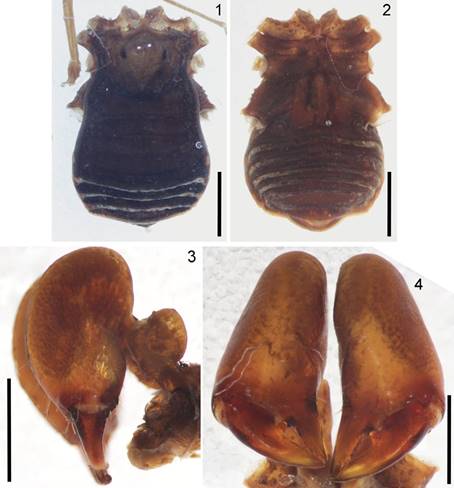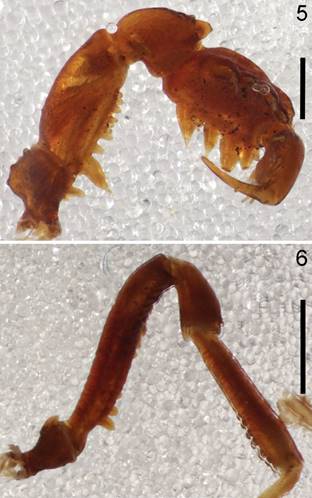Introduction
The harvestman Metaconomma femorale Pickard-Cambridge, 1905 was described as a new genus and species, from Teapa, Tabasco, Mexico. In the Biologia Centrali-Americana, the author placed the new taxon in the family Assamiidae (misspelling Assamioidae), along with the genera Conomma Loman, 1902, Mitraceras Loman, 1902 and Paramitraceras Pickard-Cambridge 1905, the last currently placed in the family Stygnopsidae Sørensen, 1932. Subsequently, Roewer (1912, 1923, 1927) cited the taxon and placed it in Phalangodidae: Phalangodinae. Some years later, Sørensen (1932) described the family Stygnopsidae, and considered this family to contain Isaeus Sørensen, 1932, Stygnopsis Sørensen, 1902 and Tachus Sørensen, 1932 (currently Tibangara Mello-Leitão, 1940). In the description of Isaeus mexicanus Sørensen, 1932 stated: “Remarks: I have not been able to reexamine this species in natura. It seems to be allied to Metaconomma Cambr. (Roewer, Weberkn. p. 115)”. Caporiacco (1938) listed a specimen of Metaconomma femorale from Ocotlán, Jalisco State, Mexico, without further details or illustrations. Finally, Kury and Cokendolpher (2000) and Kury (2003) considered M. femorale as family uncertain, and cited the record of Caporiacco from Ocotlán, presumably the one in Jalisco.
The type specimen, an adult male of M. femorale is deposited in the Natural History Museum (NHM), previously known as the British Museum of Natural History (BMNH), London. Examination of photographs of this specimen, which is in very bad condition, results in the following taxonomic nomenclatural acts: a) Metaconomma is a junior synonym of Hoplobunus Banks, 1900 and its correct family placement is in Stygnopsidae; b) the proposal of the new combination Hoplobunus femoralis (Pickard-Cambridge, 1905) comb. nov., and c) the record of H. femoralis from Ocotlán, Jalisco of Caporiacco (1938) is dubious, as we have not seen any Hoplobunus, or even other stygnopsids from that region of Mexico. With these results, Hoplobunus currently contains 2 species.
Material and methods
The type of M. femorale is deposited in the Natural History Museum (NHM), London, UK, where the photographs were taken and sent to us for examination. Nomenclature of scutum shape is based upon Kury and Medrano (2016), pedipalpal armature according to Acosta et al. (2007) and ratio of the scutum length divided by the cheliceral hand length follows Cruz-López and Francke (2013).
Description
Order Opiliones
Suborder Laniatores
Family Stygnopsidae Sørensen, 1932 Subfamily Stygnopsinae Sørensen, 1932 Genus Hoplobunus Banks, 1900
Hoplobunus Banks, 1900: 200; Pickard-Cambridge, 1905: 585; Roewer, 1912: 149, 1923: 112, 1927: 272; Goodnight & Goodnight, 1942: 1, 1945: 3, 1953: 19, 1967: 1, 1971: 38, 1973: 86; Šilhavý, 1974: 176, 1977: 220; Edgar, 1990: 548; Rambla & Juberthie, 1994: 218; Kury & Cokendolpher, 2000: 143; Kury, 2003: 237; Cruz-López & Francke, 2017: 338, 2018: 1045.
Metaconomma Pickard-Cambridge, 1905 new synonymy
Type species: Hoplobunus barretti Banks, 1900
Diagnosis. See Cruz-López and Francke, 2017: 338.
Hoplobunus femoralis (Pickard-Cambridge, 1905) comb. nov.
Metaconomma femorale Pickard-Cambridge, 1905: 576; Roewer, 1912: 152; 1923: 115; 1927: 273; Sørensen 1932: 277; Caporiacco, 1938: 279; Kury & Cokendolpher, 2000: 143; Kury, 2003: 237. (Figs. 1-6)

Figures 1-4 Type male (NHM) of Hoplobunus femoralis comb. nov. 1, Habitus dorsal; 2, habitus ventral; 3, chelicera ectal; 4, chelicera frontal. Scale bars 1 and 2 = 1.5 mm, 3 and 4 = 1 mm.

Figures 5, 6. Holotype male (NHM) of Hoplobunus femoralis comb. nov. 5, Pedipalp mesal, leg IV mesal. Scale bars 5 = 0.5 mm, 6 = 1 mm.
Diagnosis. Hoplobunus femoralis can be recognized from H. barretti by the following external characters: cheliceral fixed finger with many small contiguous teeth (Fig. 4), instead of almost smooth (Cruz-López & Francke, 2017: Fig. 11A); cheliceral hand very swollen (Fig. 3), ratio between length/width = 2.25, instead of cheliceral hand less swollen (Cruz-López & Francke, 2017: Fig. 11B), ratio between length/width = 2.5 in H. barretti; ventral tubercles of pedipalpal femur very short, the basal most prominent (Fig. 5); whereas in H. barretti all ventral tubercles are the same size, the basal most barely outstanding (Cruz-López & Francke, 2017: Fig. 10A, B); and the basal most ventral tubercles of femur IV larger than the others (Fig. 6); whereas H. barreti has the distal most ventral tubercles larger than the others (Cruz-López & Francke, 2017: 12E, F).
Redescription based on the male holotype (NHM). Scutum type zeta, mid-bulge smooth and leveled at mesotergal area I, posterior margin of scutum larger than mid-bulge area, coda I shallow. Ocularium at frontal margin, conical and with a small spine apically, eyes at the base. Mesotergal areas well defined, covered by few and small tubercles. Free tergites with few tubercles (Fig. 1). Coxae I and II with long spiniform setiferous tubercles, coxae III and IV almost smooth. Stigmatic area inverse T-shaped, spiracles visible. Free sternites without ornamentation (Fig. 2). Chelicera very swollen, ratio of scutum length divided by the cheliceral hand length = 1.35 and ratio between cheliceral length and cheliceral width = 2.25. Basichelicerite short, with the bulla well-marked. Cheliceral fingers stout, movable finger with a large rounded and large basal tooth, fixed finger with many small and contiguous teeth (Figs. 3, 4). Pedipalpal femur compressed laterally, dorsally unarmed, ventrally with a row of 9 very large spiniform setiferous tubercles, the basal most very enlarged. Patella without dorsal ornamentation, with a rounded dorso-apical apophysis. Tibia swollen and with IIII (1 = 2 = 3 = 3) enlarged spiniform setiferous tubercles on both margins, bases of these tubercles are cylindrical with the apical setae short. Tarsus with III (1 > 2 > 3) spiniform setiferous tubercles on both margins. Tarsal claw slightly longer than tarsus (Fig. 5). Only the leg IV was examined. Trochanter IV with a short, rounded dorsal apophysis. Femur with 2 ventral rows of spiniform tubercles, the basal most larger than all others. Patella with a mesal ventro-apical spiniform apophysis. Tibia with 2 ventral rows of tubercles increasing in size distally (Fig. 6). Tarsal count according to Pickard-Cambridge (1905): 6:10-11:7:7. Penis was not examined.
Female. Unknown.
Taxonomic summary
Type material: type male (NHM) from Teapa, Tabasco, Mexico, H. H. Smith leg. No more data.
False records. Caporiacco (1938) reported H. femoralis from Ocotlán, without any additional data. Posteriorly, Kury and Cokendolpher (2000) and Kury (2003) indicated that this record is from Ocotlán in the state of Jalisco. In fact, in Mexico there are at least 5 localities named Ocotlán in the states of Hidalgo, Jalisco, Oaxaca, Puebla and Tlaxcala. The family Stygnopsidae is distributed along the Sierra Madre Oriental in Mexico (Cruz-López and Francke, 2017), and at present the family has not been reported from the Sierra Madre Occidental, on the Pacific side of the country, where Jalisco is located. For this reason, we consider that the assignment of the record of Caporiacco to the state of Jalisco is dubious as it can be referred to any other Ocotlán.
On the type locality of H. femoralis. Since 2009, we have made numerous efforts to collect specimens of H. femoralis at the type locality during different seasons, and have not found any Hoplobunus, even immature stages, even though we have collected other stygnopsids and small harvestmen. Although we suspect that Pickard-Cambridge (1905) could have mistaken the type locality with another; however, in Teapa, Tabasco we have collected other species described by Pickard-Cambridge (1905) from that locality and collector, the cosmetids Erginulus clavotibialis (Pickard-Cambridge, 1905) and Heterovonones incrassatus (Pickard-Cambridge, 1905), and the sclerosomatids Leiobunum dromedarium Pickard-Cambridge, 1905, Prionostemma foveolatum (Pickard-Cambridge, 1905) and Prionostemma fulvum (Pickard-Cambridge, 1905).
Tabasco is one of those that has been most affected by deforestation and land-use change due to cattle rising in Mexico (Alejandro-Montiel et al., 2010). We suspect that our inability to find any specimens of H. femoralis and of the zalmoxid Pyropharynx gracilis (Pickard-Cambridge, 1905) in the vicinity of Teapa is because of anthropogenic habitat loss.











 nova página do texto(beta)
nova página do texto(beta)


